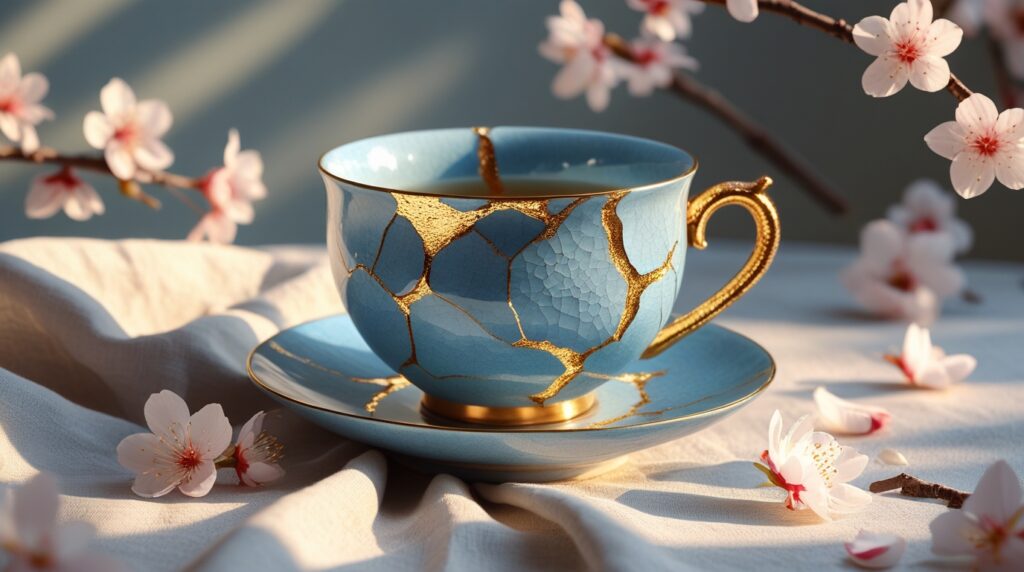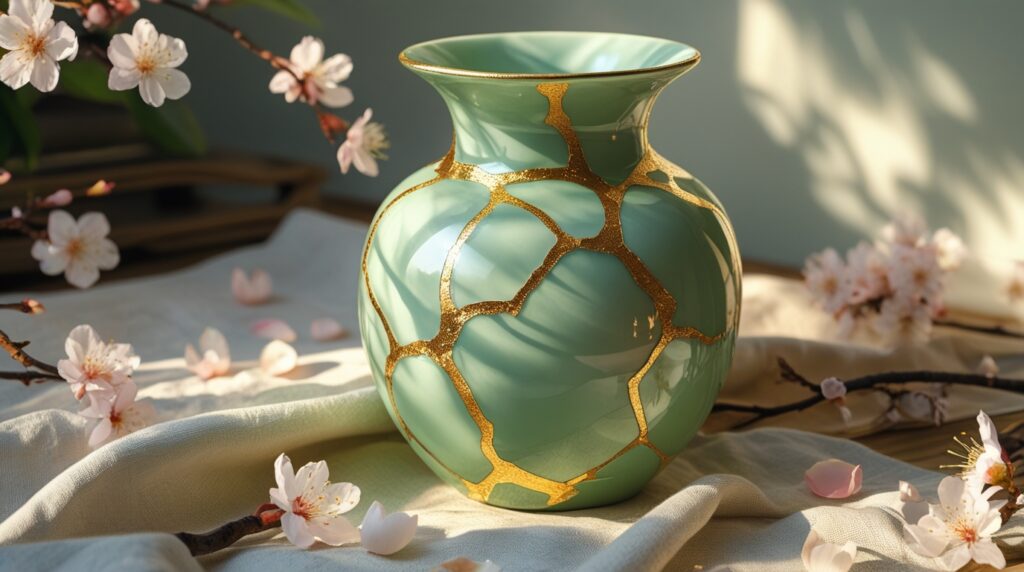How the ancient Japanese practice of mending broken pottery reveals the beauty of relational repair.
What Is Kintsugi?
Kintsugi (金継ぎ), meaning “golden joinery,” is a centuries-old Japanese art form that repairs broken pottery by filling its cracks with gold, silver, or platinum. Rather than hiding the damage, Kintsugi illuminates the breakage, transforming what was once considered flawed into something more valuable, beautiful, and whole.
Emerging in the 15th century under the Japanese aesthetic philosophy of wabi-sabi—which embraces imperfection, impermanence, and incompleteness—Kintsugi embodies the idea that scars are not just to be accepted but celebrated.
“The world breaks everyone and afterward many are strong at the broken places.”
— Ernest Hemingway
Kintsugi isn’t just a technique. It’s a mindset—a graceful, reverent acceptance of the fracture as part of the object’s history, not its failure.

Kintsugi as a Metaphor for Healing Attachment
So what does gold-laced pottery have to do with love, trauma, or how we relate to others?
Everything.
Attachment patterns—whether secure, anxious, avoidant, or disorganized—are shaped in our earliest relationships. When those bonds are inconsistent, unavailable, chaotic, or rejecting, we adapt by cracking ourselves into “safe” versions. We learn to chase love. To hide feelings. To shut down. To disappear. These are survival strategies—but they leave us feeling broken, especially in adult relationships.
Kintsugi reminds us:
You are not broken. You are healing. And your scars are gold.
Attachment Wounds Are Invisible Cracks
Imagine a child whose need for comfort was met with silence.
Or a teen whose vulnerability was mocked.
Or a young adult who kept attracting unavailable partners, confused by their own intensity or detachment.
These experiences create hairline fractures in the nervous system. They don’t show up on X-rays, but they manifest as:
- Fear of abandonment or engulfment
- Trouble setting boundaries
- Emotional flooding or disconnection
- A belief that love must be earned or feared
The healing of these patterns doesn’t mean “becoming perfect.” It means becoming integrated—like pottery, carefully restored with presence and care.

The 3 Stages of Kintsugi-Inspired Healing
1. Acknowledging the Break
In Kintsugi, the first step is honoring that the item is broken—not discarding it or gluing it quickly, but pausing with reverence.
Healing attachment begins here too.
You say:
- “I learned to perform because I feared rejection.”
- “I pull away when things get real.”
- “I’ve confused chemistry with safety.”
Acknowledgment is sacred. It’s where the gold begins.
“We cannot heal what we do not name.”
— Dr. Thema Bryant
2. Choosing Repair, Not Replacement
Kintsugi does not replace the shattered bowl. It gently pieces it back together.
In attachment healing, this means:
- Re-parenting your inner child with warmth and consistency
- Practicing secure communication
- Learning to regulate your nervous system when triggered
- Building new relationships that honor your truth
Secure attachment isn’t something you were born with or without.
It’s something you practice into being.
3. Making the Cracks Beautiful
Gold is applied not to hide the fracture, but to honor it.
Imagine saying:
- “I get anxious, but I’ve learned to soothe myself instead of spiraling.”
- “I used to ghost when things got hard, but now I ask for space and return.”
- “I used to feel unworthy of love. Now I choose partners who value my heart.”
These aren’t flaws. These are gold lines.
“Our wounds are often the openings into the best and most beautiful part of us.”
— David Richo

💡 Real-Life Examples of Kintsugi in Relationships
🌸 Erin, 32 – Anxious Attachment
Erin used to panic when her partner didn’t text back. She would spiral into overthinking and send a dozen messages. After doing inner child work, she started placing her hand on her heart and saying: “It’s okay to wait. I am still loved.” She now uses her anxious energy as a cue for deeper self-trust—not reaction.
🪵 Jason, 45 – Avoidant Attachment
Jason avoided commitment for years. When a relationship got close, he found excuses to leave. After recognizing his fear of being overwhelmed, he began therapy and started naming his emotions. He still needs space—but now, he takes it with transparency and returns with intention.
These are gold repairs. Not perfection—integration.
💬 Expert Insight
“When we deny our wounds, we deny our wholeness. Secure attachment is not the absence of fear—it’s the presence of self-awareness and repair.”
— Dr. Diane Poole Heller
“Kintsugi shows us that healing is not hiding. It’s revealing—and even revering—what once threatened to break us.”
— Spirit Love Song™

Embrace Your Own Kintsugi Practice
Try this:
- Journal about a relational wound you carry
- Write a sentence like: “The crack in me is… but the gold I’m adding is…”
- Read it aloud
- Repeat it when you feel triggered or ashamed
“The crack in me is fear of being left.
The gold I’m adding is self-trust.”
Bibliography
- Heller, D. P. (2009). The Power of Attachment
- Bowlby, J. (1988). A Secure Base
- van der Kolk, B. (2014). The Body Keeps the Score
- LePera, N. (2021). How to Do the Work
- Yoshiko, W. (2019). Kintsugi Wellness: The Japanese Art of Nourishing Mind, Body, and Spirit
#KintsugiHealing #AttachmentHealing #KintsugiMetaphor #EmotionalRepair
#SecureAttachment #SelfCompassion #AnxiousAttachment #AvoidantAttachment
#HealingIsBeautiful #MentalHealthAwareness #WabiSabiWisdom
#SpiritLoveSong #InnerChildHealing #RelationalHealth #YouAreTheGold



